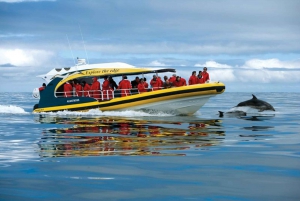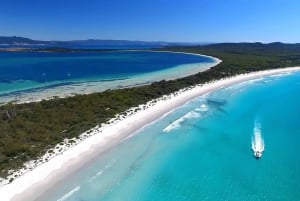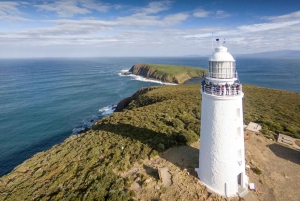Weather Overview
Tasmanian Bureau of Meteorology area forecasts:
Hobart and Southeast
Upper Derwent
Launceston and Central North
North West Coast
Western Wilderness
East Coast
North East
Central Highlands
Midlands
King Island
Flinders Island
Tasmania has a temperate maritime climate with four distinct seasons. From warm sunny summer days and mild evenings, to cool winter days ideal for enjoying the snowfields and crisp clean air. The weather is similar to many European countries, and is slightly warmer and with less rain in the main population areas. For those who want an in-depth view of the weather the Australian Bureau of Meteorology have a fantastic website.
Spring and autumn (fall) bring out the beauty of Tasmania. The luxuriant greens in the new growth of spring and the blazing reds and oranges of autumn, particularly the deciduous beech of the highlands.
Although Tasmania is small, roughly the same size as Ireland, there is a marked variation in temperature, rainfall, and geography throughout.
With Tasmania's compact size and first rate road network, it's possible to play in the snow in the morning and spend the afternoon at the beach.
No place in Tasmania is more than 115km from the sea and most population centres and major industries are on or near the coast.
Temperatures and rainfall
Summer temperatures are usually in the low to mid twenties with winter in the low teens.
Average annual rainfall for Launceston is 674mm while areas of the west coast can be over 2000mm.
With such variation in rainfall throughout the state comes a wide range of vegetation from the rainforests of the west to open plains in the midlands and the alpine regions of the mountainous central highlands.
Seasons
"Sunshine is delicious, rain is refreshing, wind braces us up, snow is exhilarating; there is really no such thing as bad weather, only different kinds of good weather." -- John Ruskin
Summer in Tasmania (Dec-Feb) is the warmest time of the year and the most popular time to visit. A great time for escaping those European winters. With the Tasmanian mainland coastline of 2833 km there are plenty of beautiful secluded beaches to explore with some big breaks available on some for great surfing. With over 35% of Tasmanian land set aside in parks and reserves summer is a perfect time for bush walking and getting back to nature.
Autumn (Mar-May) sees the landscape turn to gold with Tasmania’s European heritage showing as many of the historic towns having oak, ash and elm trees that were planted in colonial times. Enjoy the harvest of fresh produce that Tasmania is famous for. Enjoy some of Tasmania’s wonderful autumn festivals including the Richmond Harvest Festival and the Derwent Valley autumn festival.
Winter (Jun-Aug) is time for playing in the snow and warm nights by the fire. Tasmania is known for putting on all four seasons in the one day so warm clothing that you can layer is the go. Even in winter the days can be warm especially if you are walking. I find polar fleece to be excellent for layers with a light rain jacket as needed. Winter is also good for the fact of avoiding the throngs that are about in peak season and things are a bit more laid back and relaxed.
Winter offers some of the best whale viewing in Australia, with migrating pods of Southern Right Whales and Humpback Whales off both the east and west coasts.
Spring in Tasmania (Sep-Nov) is my favourite time of year with the weather warming up and blossoms heralding the new growing season. The pastures are all green with newborn lambs and kids to be seen. Spring is a great time for trout fishing in one of the many beautiful lakes or waterways throughout the island.
"There's no such thing as bad weather, only unsuitable clothing." -- Alfred Wainwright
 1 °C
1 °C
 overcast clouds
overcast clouds scattered clouds
scattered clouds few clouds
few clouds light snow
light snow overcast clouds
overcast clouds light rain
light rain light snow
light snow clear sky
clear sky clear sky
clear sky few clouds
few clouds clear sky
clear sky clear sky
clear sky clear sky
clear sky clear sky
clear sky few clouds
few clouds scattered clouds
scattered clouds broken clouds
broken clouds overcast clouds
overcast clouds overcast clouds
overcast clouds overcast clouds
overcast clouds overcast clouds
overcast clouds overcast clouds
overcast clouds light rain
light rain overcast clouds
overcast clouds overcast clouds
overcast clouds broken clouds
broken clouds broken clouds
broken clouds scattered clouds
scattered clouds scattered clouds
scattered clouds broken clouds
broken clouds broken clouds
broken clouds few clouds
few clouds scattered clouds
scattered clouds











